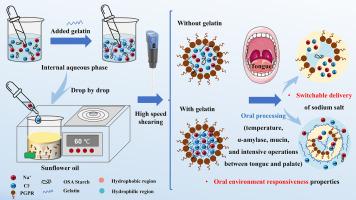Oral environment responsiveness of switchable water-in-oil high internal phase emulsions-based sodium salt carrier mediated by gelatin: Temperature sensitivity, phase inversion, and saltiness perception
IF 8
1区 农林科学
Q1 FOOD SCIENCE & TECHNOLOGY
引用次数: 0
Abstract
Water-in-oil high internal phase emulsions (W/O HIPEs) with oral environment responsiveness were constructed based on the internal aqueous phase gelation by gelatin for switchable delivery of sodium chloride. The effect of gelatin addition on the physical stability, saltiness perception, rheological behavior, and microstructure of W/O HIPEs was investigated. The formation of the three-dimensional gel network structure of the internal aqueous phase fortified by gelatin contributed to increasing the apparent viscosity and reducing the water-oil mobility of W/O HIPEs, thereby enhancing their stability. During oral processing, the presence of gelatin extended the duration of saltiness perception of W/O HIPEs (Tmax ≥ 14.7) without affecting its intensity (Imax = 5.9), which was related to the melting temperature of gelatin being close to physiological temperature (37 °C). Under the combined action of mucin, α-amylase, temperature, and intensive tongue-palate operations, the phase inversion from W/O to W1/O/W2 emulsion, encouraged the sodium salt to burst release, enhancing the saltiness perception. Furthermore, the hydrophobic interaction between gelatin and mucin impaired the stability of W1/O/W2 emulsions, accelerating the occurrence of phase inversion. Altogether, these findings offer valuable insights for developing novel reduced-fat and reduced-salt food products.

明胶介导的可切换油包水高内相乳剂型钠盐载体的口腔环境响应性:温度敏感性、相转化和咸味感知
以明胶为基础,构建了具有口腔环境响应性的油包水高内相乳剂(W/O HIPEs),用于切换输送氯化钠。研究了明胶加入对W/O HIPEs的物理稳定性、咸味感、流变行为和微观结构的影响。明胶强化的内部水相形成了三维凝胶网络结构,提高了W/O HIPEs的表观粘度,降低了水油流动性,从而增强了其稳定性。在口腔加工过程中,明胶的存在延长了W/O HIPEs的咸味感知持续时间(Tmax≥14.7),但不影响其强度(Imax = 5.9),这与明胶的熔化温度接近生理温度(37℃)有关。在粘蛋白、α-淀粉酶、温度和强烈的舌-腭操作的共同作用下,由W/O型乳化液向W1/O/W2型乳化液相转变,促使钠盐爆裂释放,增强了盐感。此外,明胶和粘蛋白之间的疏水相互作用降低了W1/O/W2乳剂的稳定性,加速了相反转的发生。总之,这些发现为开发新型低脂低盐食品提供了有价值的见解。
本文章由计算机程序翻译,如有差异,请以英文原文为准。
求助全文
约1分钟内获得全文
求助全文
来源期刊

Food Research International
工程技术-食品科技
CiteScore
12.50
自引率
7.40%
发文量
1183
审稿时长
79 days
期刊介绍:
Food Research International serves as a rapid dissemination platform for significant and impactful research in food science, technology, engineering, and nutrition. The journal focuses on publishing novel, high-quality, and high-impact review papers, original research papers, and letters to the editors across various disciplines in the science and technology of food. Additionally, it follows a policy of publishing special issues on topical and emergent subjects in food research or related areas. Selected, peer-reviewed papers from scientific meetings, workshops, and conferences on the science, technology, and engineering of foods are also featured in special issues.
 求助内容:
求助内容: 应助结果提醒方式:
应助结果提醒方式:


